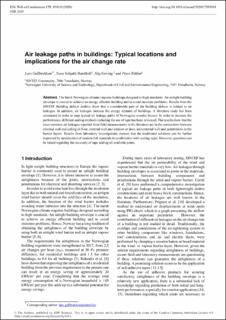| dc.contributor.author | Gullbrekken, Lars | |
| dc.contributor.author | Bunkholt, Nora Schjøth | |
| dc.contributor.author | Geving, Stig | |
| dc.contributor.author | Rüther, Petra | |
| dc.date.accessioned | 2020-08-11T08:57:45Z | |
| dc.date.available | 2020-08-11T08:57:45Z | |
| dc.date.created | 2020-08-10T11:17:06Z | |
| dc.date.issued | 2020 | |
| dc.identifier.citation | E3S Web of Conferences. 2020, 172 . | en_US |
| dc.identifier.issn | 2267-1242 | |
| dc.identifier.uri | https://hdl.handle.net/11250/2671425 | |
| dc.description.abstract | The harsh Norwegian climate requires buildings designed to high standards. An airtight building envelope is crucial to achieve an energy efficient building and to avoid moisture problems. Results from the SINTEF Building defects archive show that a considerable part of the building defects is related to air leakages. In addition, air leakages increase the energy demand of buildings. A literature study has been conducted in order to map typical air leakage paths of Norwegian wooden houses. In order to increase the performance, different sealing methods including the use of tape has been reviewed. The results show that the most common air leakages reported from field measurements in the literature are in the connections between external wall and ceiling or floor, external wall and window or door, and external wall and penetrations in the barrier layers. Results from laboratory investigations showed that the traditional solutions can be further improved by introduction of modern foil materials in combination with sealing tapes. However, questions can be raised regarding the necessity of tape sealing all available joints. | en_US |
| dc.language.iso | eng | en_US |
| dc.publisher | EDP Science | en_US |
| dc.relation.ispartof | 12th Nordic Symposium on Building Physics (NSB 2020) | |
| dc.rights | CC BY 4.0 | * |
| dc.rights.uri | https://creativecommons.org/licenses/by/4.0/ | * |
| dc.subject | Buildings | en_US |
| dc.subject | Air leakage | en_US |
| dc.subject | Energy consumption | en_US |
| dc.subject | Wooden houses | en_US |
| dc.title | Air leakage paths in buildings: Typical locations and implications for the air change rate | en_US |
| dc.type | Peer reviewed | en_US |
| dc.type | Conference object | en_US |
| dc.type | Journal article | en_US |
| dc.description.version | publishedVersion | en_US |
| dc.rights.holder | © 2020 The authors | en_US |
| dc.subject.nsi | VDP::Teknologi: 500 | en_US |
| dc.source.pagenumber | 7 | en_US |
| dc.source.volume | 172 | en_US |
| dc.source.journal | E3S Web of Conferences | en_US |
| dc.identifier.doi | 10.1051/e3sconf/202017205010 | |
| dc.identifier.cristin | 1822370 | |
| dc.relation.project | Norges forskningsråd: 294894 | en_US |
| dc.source.articlenumber | 05010 | |
| cristin.ispublished | true | |
| cristin.fulltext | original | |
| cristin.qualitycode | 1 | |

